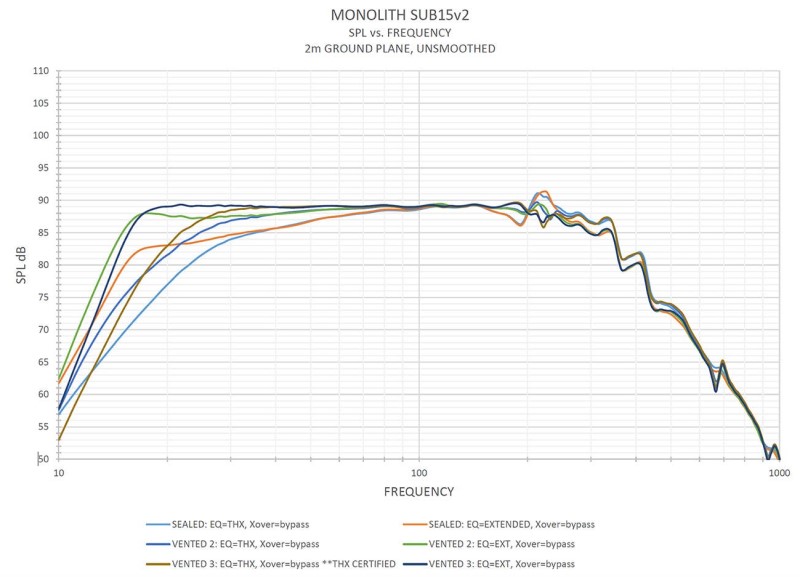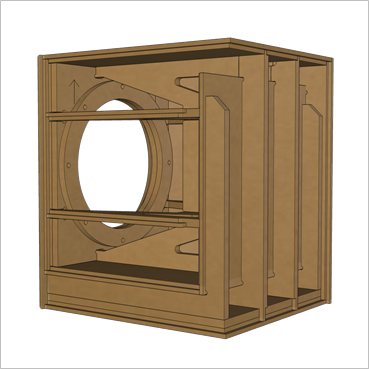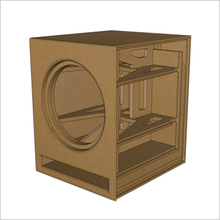Is a DIY Subwoofer Worth It?
When you are on a serious budget, the idea of DIY (or Do It Yourself) options are often suggested. A whole industry has been built up around the DIY crowd. The argument is that you can save a bunch of money by building your own subwoofer. But is this true? Is a DIY subwoofer really worth it? Do they really save you that much money? Let’s crunch some numbers!
What We Will Be Comparing
One of the more popular DIY subwoofer options out there are the MartySubs. You can’t swing a stick around a home theater forum and not hit a comment from someone that owns one or suggests one (it seems). To sum up, they sell the enclosure for the subwoofer and provide assembly instructions and a shopping list. It is up to you to buy or already own all the appropriate tools. While assembly isn’t all that complicated, getting a professional finish equivalent with store-bought subwoofers will require some skill. Plus, you’ll need to purchase all the extra stuff (like the driver, amps, glue, screws, etc.) that you’ll need. Lastly, it’ll take time. How much? That will depend on your skill and probably the quality of your tools.
For this article, we’ll be comparing the smallest MartySub offering – the Roundover MartySubs v2.1 15″ subwoofer. We’ll be comparing this to the Monoprice Monolith M-15 V2 subwoofer. Will the MartySub DIY solution be worth the savings over the Monoprice subwoofer?
Basic Specs
| Monoprice M-15 V2 | MartySub 15″ | |
| Size | 28.7″ x 17.7″ x 26.8″ | 23.0” x 20.0” x 25.5” |
| Driver Size | 15″ | 15″ |
| Driver | Included | Dayton RSS390HO ($269) |
| Amp | Included | Dayton SA1000 ($499) |
| Enclosure | Included | $359 |
| Price | $1500 | $1127 |
Sizewise, they are pretty close. The Monoprice is longer but not quite as wide as compared to the MartySub. The prices are obviously much different until you factor in the driver and the amplifier. But the MartySub doesn’t factor in all the tools, hardware, finishing materials, and time it will take to finish off the sub.
Performance Comparison
From a performance standpoint, it is a little harder to compare the DIY subwoofer to the purchased one. If we look at the MartySub’s specs, they list >115dB @ 24hz as the only performance specification. The Performance Comparison table (link) doesn’t have any information on the subwoofer driver listed. It is not exactly unexpected that they don’t list specific performance. They don’t know which driver you will use, which amp, and how well you’ll construct the cabinet (all of these matter).

Monoprice, on the other hand, can provide very specific performance measures. They have graphs, -3dB points, and multiple port options. If we look at the table provided by Monoprice, they list their max output at 25Hz at 116dB at 2 meters and 113dB at…we don’t know. It just says “Peak.”
So, we can safely assume that the MartySub probably plays louder. How much? Some much. Just not sure how much. But does that make the DIY subwoofer worth more than the store-bought?
Which is Worth More, the DIY or Store Bought Subwoofer?
If you look at the two subwoofers in question, the DIY version is clearly less expensive. You can save almost $400 with the MartySub. But that’s assuming a lot of things. It assumes that you have all the tools, hardware, and finishing materials necessary. This also assumes that you have the expertise to assemble the subwoofer without messing it up. You must also not value your time at all.


That last part is really the clincher. Think about how much you make an hour. If you are on salary, you can still figure that out (though it might be depressing if you do). That is how much your employer values your time. Do you think they pay you as much as you are worth? No? Then add that to the equation. That is how much your time is worth. Now look over the plans for assembling the DIY subwoofer and use your hourly worth to add to that price. Is the MartySub really saving you any money? Or are you paying more for the DIY subwoofer over the store-bought simply in materials and time?
Let’s say you make $15 an hour. Not a lot, I know. But if it takes you 10 hours to make a DIY subwoofer, that’s $150 is labor. Now, that isn’t including any extra money you spent. That’s also not factoring the aggravation factor.
Do you change your own oil? It isn’t hard. I did it for years. But I don’t anymore. Why? Because it is dirty and it is a hassle. I don’t like doing it. I don’t like doing it so much that I pay someone else a lot more than $15 for the less than an hour it takes them to do it. That’s the aggravation cost and, at least for me, building my own DIY subwoofer would not be worth it.
But…
Before you start angrily typing into the comments, we get that some people like to do this stuff. For some people, working with their hands, learning new things, or just having a project is a form of relaxation. That the work is rewarding enough that they might actually pay to do it (think of all the people that take pottery or glass-blowing classes).
For people like that, building the DIY subwoofer isn’t a chore, it is fun and worth every minute! It may be because they like the process or that they like that they can point at the final product and say, “I built that.” At the very least, their enjoyment offsets some of the labor costs we would have added to the price of the DIY subwoofer.
The problem is that most people (or at least many people) aren’t like that. They don’t have all the tools (the clamps needed can nearly equal out the DIY and store-bought subwoofer price) so the DIY route is simply not worth it. Add in all the rest of the hardware, the need to either live with a raw MDF cabinet or learn how to finish it (plus pay for those materials), and all the rest…the numbers don’t add up.
Wrap Up
We’ve compared one of the price leaders in subwoofers (the Monoprice) to one of the most popular DIY subwoofer solutions (the MartySubs) to compare their worth. It would be easy to find another store-bought subwoofer that would cost a multiple of the MartySub with a fraction of the performance. In those cases, the calculation of worth changes so that the DIY subwoofer is the clear winner. If you are a woodworker with all the tools and expertise, the DIY subs are a great value. If you are just a normal person trying to save some money, you need to make sure you know what you are getting yourself into. Assembling and finishing a DIY subwoofer is more involved than you may think.
Do you have a DIY subwoofer? Do you think that it saved you money in the end? Let us know in the comments below.


